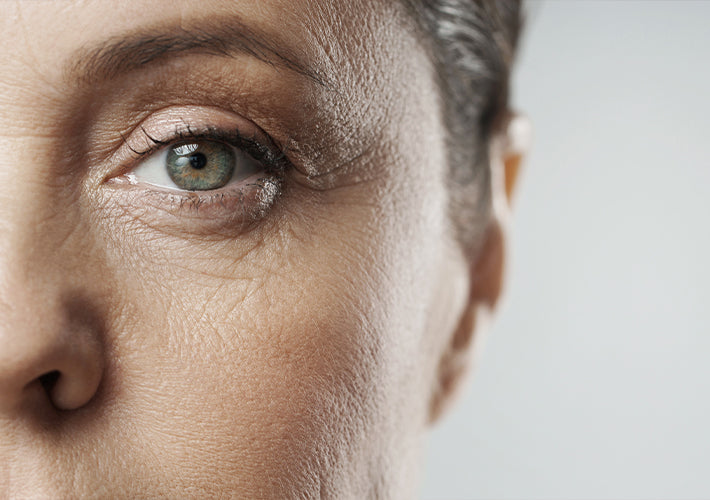
Aging Eyes
Posted by Terri Wojak on
Many people have caught on to how important playing up their eyes can be—after all, the eyes are known as the focal point of the face. Unfortunately, the eyes are often the first area to show signs of aging due to the difference in skin structure. The skin surrounding the eyes is up to ten times thinner compared to other areas of the face. The thinner skin around the eyes not only provides less support, but it also makes imperfections including dark circles, puffiness, fine lines and wrinkles more noticeable. There are several methods that can be used to aesthetically enhance the eye area, including medical procedures, skin care treatments, and product use at home.
Prevention
To preserve a youthful appearance, protection is key, especially in the eye area. It is well known that diligent sun protection and a healthy lifestyle are the best ways to avoid prematurely aging skin. The use of UVA and UVB protective sunglasses should be recommended for optimal protection. Preventing the signs of aging around the eyes is also accomplished with topical products. The difference in structure and function of this skin is the reason that there are products made specifically for the eyes. The eye area has minimal sebaceous glands compared other areas of the face. More moisture should be applied topically to keep it soft and supple, helping prevent the appearance of aging. When choosing products
to protect the eye area, the use of antioxidants should also be incorporated to protect against further damage. Ingredients, such as vitamins A, C and E, are commonly used. Hyaluronic acid, ceramides and peptides should also be added to support the health of the skin.
Topical Products
Once fine lines and wrinkles around the eyes, commonly known as crow’s-feet, have set in, more advanced topical products can be added to a skin care regimen. Products containing peptides that protect and trigger the production of matrix proteins, collagen and elastin are often chosen, due to their remarkable results and reduced possibility of irritation associated with their use. Neuropeptides, such as argirilene, are a great addition to eye products due to their ability to reduce the effects of muscle contraction over time. Vitamin A should also be recommended to address the appearance of fine lines on the outer perimeter of the eyes. Vitamin A is known to trigger cell turnover and increase the benefits of collagen production. The lipid-soluble forms of vitamin A tend to be the best around the eyes due to their low irritation rate.
Needling
The use of cosmetic needling, with needle depths ranging from .1mm- .3mm, has become increasingly popular, especially for the eye area. Cosmetic needling may allow products to be delivered up to 100 times more effectively than putting products on alone. Clients can perform cosmetic needling on themselves with a roller or stamp on a nightly basis before product application. Medical Microneedling, also called Collagen Induction Therapy, is the use of small needles to create micro-channels in the skin to stimulate a wound-healing response. The needles vary in depth from .5 mm – 3.0mm. The wound response triggers collagen and elastin production resulting in thicker skin with fewer lines and wrinkles, as well as a more even skin tone. A series of microneedling treatments is commonly performed in a medical setting at three to four-week intervals. The provider will assess the skin and the condition before making recommendations as to how many treatments should be performed.
Equipment-based treatments
Equipment-based treatments, such as microcurrent and light-emitting diodes (LED), are helpful in reducing lines around the eye area. Microcurrent is known for its ability to retrain muscles using electrical current and specific movements. Clients often say they see the most improvement with lifting in the brow area when receiving microcurrent. LED works by simulating circulation and increasing the metabolism of cells, including fibroblasts, resulting in smoother skin. Proper eye protection should be worn for each treatment. Multiple treatments should be expected with microcurrent and LE; these are not one-time solutions and maintenance with topical products is necessary to preserve results.
Clients with deeper set lines, who want to speed up the process, may be referred to a medical office for more aggressive treatments. Some of the more commonly used devices for treating the eye area are fractional lasers, radiofrequency, and micro-focused ultrasound. Each of these modalities use varying types of energy to heat the skin, resulting in tissue contraction and ultimately collagen stimulation. There are opposing theories about these treatments, as they can be destructive if not used properly.
There are several ways to improve the appearance of the skin around the eyes from home care to medical aesthetic treatments. Each client is different and will experience various results per treatment. Some notice great benefits from the use of products alone; others may need to seek medical treatment before results are seen. Ultimately the best results can be obtained from both professional services and home care.
Share this post
- Tags: Great Skin Habits, Science, Skincare
